By Sarah Ellis
St. Augustine is known for its ability to enchant tourists and locals with its unique atmosphere. On any given day, St. George Street is not only full of tourists walking around and taking in the sights, but it also serves as a stage for local musicians taking part in street performing or busking.
A trio of buskers filling the street with true-blue American music break-down their path of artistry and what it’s like to be street performers for a living.
Ramblin’ Roach, Amanda Syrinek and Ayron Moleen are three musicians who came together to perform for a day off St. George Street, unique in the fact that they’re a trio and an all femme-presenting act.
Roach is a nonbinary French-Canadian artist currently busking their way through the States, following the vibes. Roach plays the banjo aptly named, Charlene.
“I’m just having a good time and trying to make some money to travel and go back home,” Roach said.
Moleen is the lead singer of a local Florida band called Blossomin’ Bone, and additionally plays the guitar and percussion.
“We just wanted a girls’ day, to come down and busk and kick it,” Moleen said. “This is actually the first time we’ve busked together.”
Amanda Syrinek is also a member of Blossomin’ Bone playing the washboard.
“I love playing the street because people learn things and they hear stuff they would’ve never heard otherwise,” Syrinek said.
The desire to busk can come from many different places, but in many cases it can come from a need. As it was for Roach, whose husband introduced them to busking as a way to make a living after having a bad experience working and needing an alternative to panhandling.
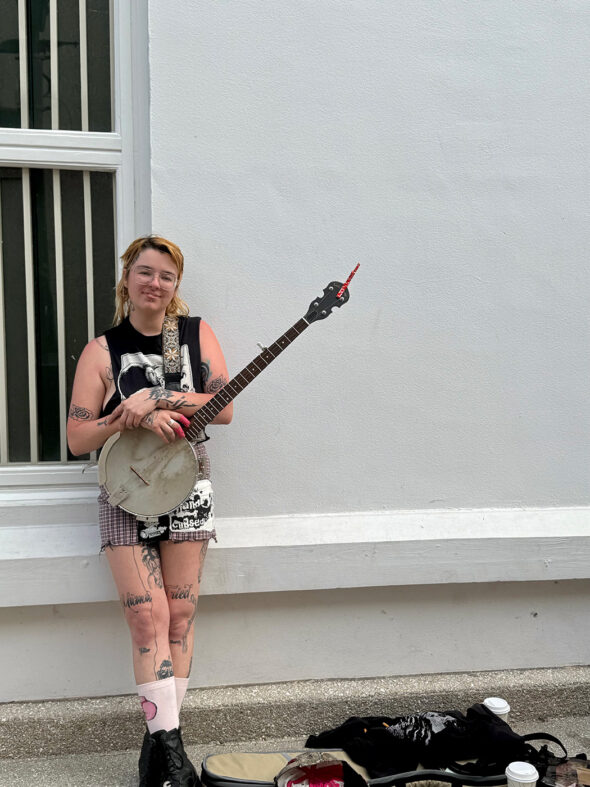
“I had a very bad experience working and just decided that I was going to go begging or panhandling,” Roach said. “I met my husband and he started showing me what busking was. You get into busking because you want to make some money, but it’s also a political statement if you ask me. Because people don’t buy CDs anymore. People don’t go and see shows, but if they have a dollar to spare or two or some change. It’s bringing the accessibility of my songs to the street.”
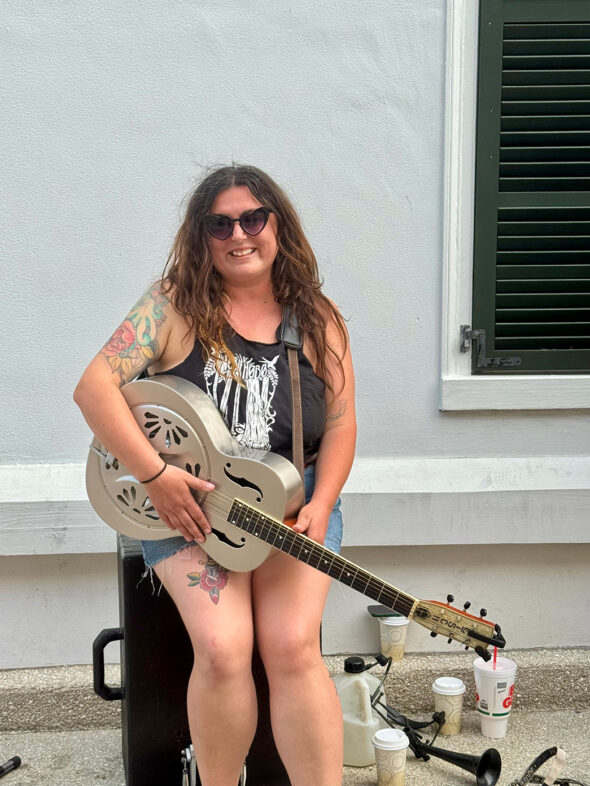
Like Roach, Moleen also got introduced to busking by her husband, who has been busking since he was 16 years old. He shared busking with Moleen, who had never been introduced to busking before, leading to a longstanding music career.
“It’s so fun, man. The first time we ever did it, we were at a gas station. We were busking for gas and I was so nervous, and from there it became its own entity,” Moleen said. “You don’t know who you’re going to meet. You don’t know who you’re gonna’ interact with.”
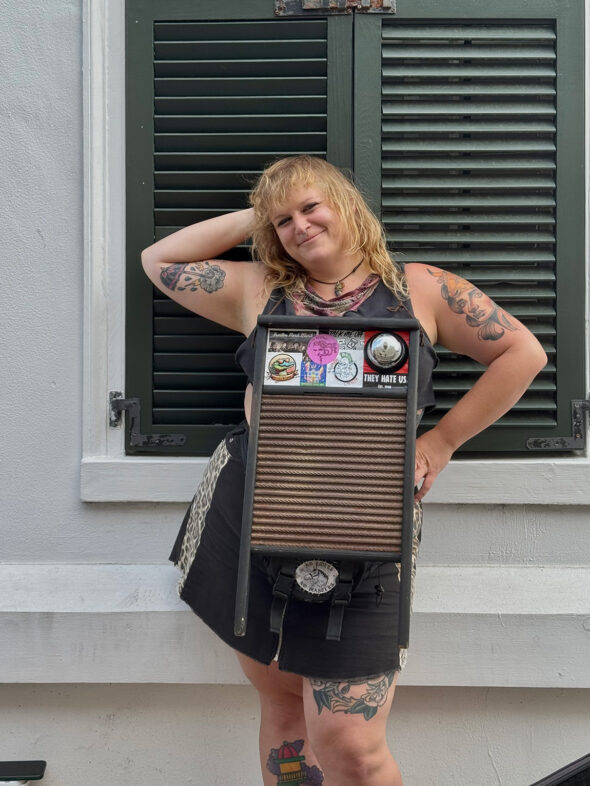
For Syrinek, busking was just a way of life to her; street performing from childhood after her father introduced busking to her. Syrinek started busking on the Daytona Beach Pier with her father as a child, and fell in love with the art form.
“I love busking. We’re playing a whole bunch of shows and we’re gigging, but I love this, and that’s why I was reminding her [Moleen] earlier, no matter what anybody expects from you, I’m a street performer,” Syrinek said. “I don’t have a cord that’s following me or a mic that I have to stand in front of. The amount of children that I’ve seen be interested in this and be pumped about music, that’s the whole thing. Parents and old people that haven’t heard this sound in a long ass time, they’re coming through, hearing it and it just gets the whole street pumping, where before there was nothing here.”
Though busking has been an amazing experience overall for Roach, Syrinek and Moleen, it does have its drawbacks at times, especially for people who are femme presenting.
For female performers or femme-presenting performers like Roach, there is less of a barrier between them and the public, with men often taking advantage of perceived female consent.
“It’s a thing people will sexualize you without your consent,” Roach said.
Still Roach encourages young women and other femme presenting-queer people to not let that stop them.
“I’ve seen on Reddit Threads that if you’re a woman or a woman-presenting, and if you go busk, always go busk with a man, and I’m like ‘No, that’s not it,’” Roach said. “I go busking alone. I am not afraid because if I start being afraid, I’m not going to live.”
Moleen also stresses that the public tends to find female buskers to be more accessible and that there can often be a lack of boundaries between performer and audience, emphasizing that women shouldn’t take any abuse from male on-lookers.
“Those kinds of people they see, especially women, by themselves, and they think that they can do whatever, like they’re entitled,” Moleen said. “I find that I’m a very open and very soft person by nature, but like when we’re out here you really have to have your guard up.”
Syrinek, who by all means loves busking and busking with women, has also faced her fair share of problems street performing, but she definitely takes a very forward approach to dealing with their inappropriate behavior.
“I can make you more uncomfortable than you can ever make me feel, I promise you that,” Syrinek said.
Though busking has its downsides, it has far more upsides for performers, and it can create opportunities that wouldn’t have happened if not for busking.
For Syrinek, her best experience busking was with the rest of Blossomin’ Bone outside Grammy Award-winning artist Sierra Ferrell’s show near Ponte Vedra, Fla., where they got to be the artist and be in her music video for her song American Dreaming.
“She did a shout out on the stage, then she came after the show and invited us into her tour bus,” Syrinek said. “Sierra Ferrell is a real one. She brought us into the arena and she put us on her stuff, just from busking outside.”
Moleen’s busking highlight is when members of her artist collective at The Connex, a punk house that brings together local artists to uplift and support them, busked a Matt Heckler concert.
“A lot of us went and busked Matt Heckler and he was so welcoming and so cool,” Moleen said. “It’s just really nice to see this surge in ‘Americana,’ and the folks that were doing what we’re doing now. Most of them are true blue and being here for us, that’s pretty much the best part of it.”
For Roach, the best thing that’s happened to them because of busking was finding their chosen family after going through a dark time in their life and dealing with grief.
“It was a very weird grieving time and stuff and I went to that festival and met them,” Roach said. “I literally wrote my entire album and just here right now I’ve learned so much.”
Though busking has its ups and downs, Roach, Syrinek and Moleen still encourage young people, especially young women, to go out into the world and share their art.
“Absolutely,” Moleen said. “It’s so liberating, once you get past that aspect of cringe. Cringe is dead, man.”
There aren’t many spaces made for women or queer people, Roach encourages that young people need to carve out a space for themselves because it won’t just be handed to them.
“You have to take your space because, I’m sorry, but if you were born with tits or a vagina, you are placed in a box,” Roach said. “You have this box and you can only take up a quarter of it and if even a hair passes over that quarter, people will try to replace you on the spot. So, I really think that women, queer people and any minority, you have to make space for yourselves.”
For Syrinek and for many other women like her, busking is empowering and just fun.
“Be safe and have fun,” Syrinek said. “You never know what’s lying beneath people. I’ve never been scared busking as a woman. I don’t have a fear that somebody’s gonna come take me.”
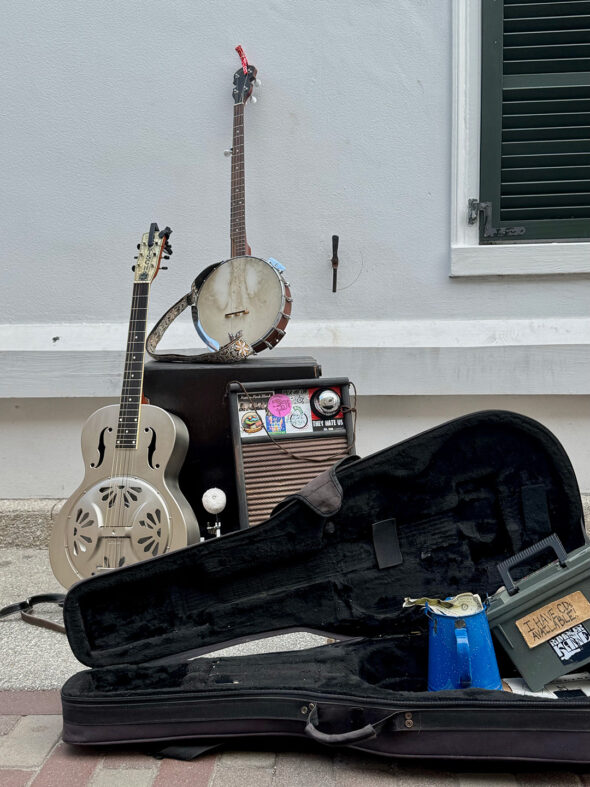

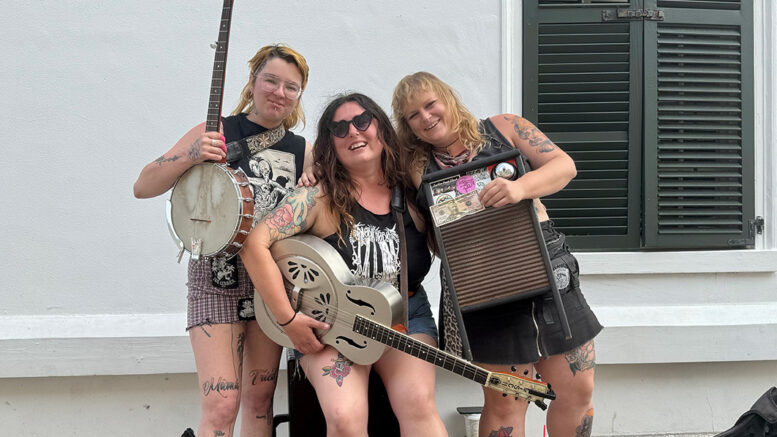

Be the first to comment on "Busking: The Art of Street Performing"